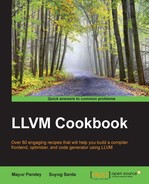Now that a full-fledged lexer and parser for our TOY language grammar are defined, it's time to run it on example TOY language.
To do this, you should have understanding of TOY language grammar and all the previous recipes of this chapter.
Run and test the Lexer and Parser on TOY Language, as shown in the following:
- First step is to compile the
toy.cppprogram into an executable:$ clang++ toy.cpp -O3 -o toy
- The
toyexecutable is our TOY compiler frontend. Thetoylanguage to be parsed is in a file calledexample:$ cat example def foo(x , y) x + y * 16
- This file is passed as argument to be processed by the
toycompiler:$ ./toy example
The TOY compiler will open the example file in read mode. Then, it will tokenize the stream of words. It will come across the def keyword and return DEF_TOKEN. Then, the HandleDefn() function will be called, which will store the function name and the argument. It will recursively check for the type of token and then call the specific token handler functions to store them into respective ASTs.
- The aforementioned lexer and parser do not handle errors in syntax except a few trivial ones. To implement Error handling, refer to http://llvm.org/docs/tutorial/LangImpl2.html#parser-basics.
..................Content has been hidden....................
You can't read the all page of ebook, please click here login for view all page.
